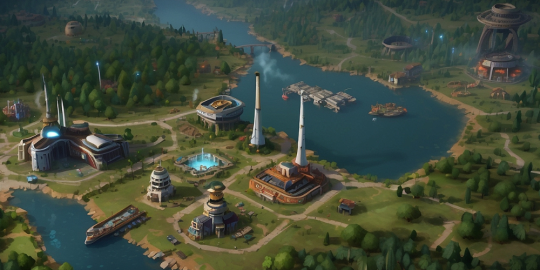
In the constantly changing world of video games, shifting trends and rapid changes in popularity present a daunting landscape for both developers and players. Within this context, the story of Concord emerges as a cautionary tale of misalignment with player expectations and market dynamics. Launched amidst significant hype, this title gave the impression of a promising gaming experience, only to fizzle out in an astonishingly short span. This begs the question, what lessons can be drawn from its surprisingly brief existence? Below, we delve into the multifaceted aspects surrounding the rise and fall of Concord and the implications for the gaming industry as a whole.
Background of Concord

Concord was brought to life by Firewalk Studios, who dedicated almost eight years to its development. Positioned as Sony's answer to the live-service model, it aimed to join the ranks of popular titles like Overwatch and Apex Legends. With extensive resources and backing from a major platform holder, expectations were high for this title upon its release on August 23, 2024.
An Unrushed Launch
Despite its lengthy development period, the game fell flat shortly after its debut. Within just 11 days, its servers faced closure, marking a stark contrast to even the most notable flops in the gaming space. In a world where many games struggle to find footing, the brevity of Concord's life was almost unprecedented.
The Disappointing Trend of Live-Service Games
The trajectory of Concord encapsulates a broader concern within the gaming community regarding the live-service model. As the industry has shifted heavily toward this approach, numerous titles have fallen short. Concord represents not just a singular failure but a statement about an overarching pattern within game development.
Comparison with Other Failures
In the wake of Concord's demise, comparisons to other struggling titles can't be ignored. Games like Babylon’s Fall, which lasted about six months, and Anthem, which somehow persisted for over five years, highlight the stark difference in longevity. Notably, players are given pause when considering how some games endure much longer despite facing their own myriad of challenges.
Market Dynamics and Preferences

A crucial factor contributing to Concord's rapid downfall was its failure to recognize changing player preferences. At the time of its release, enthusiasm for hero shooters had substantially waned, with gamers shifting their attention towards genres like battle royale and tactical shooters. This gap in understanding led to a missed opportunity for a game that may have once thrived.
Misjudged Expectations
The seemingly strong foundation of Concord, rooted in years of development, ironically became its Achilles' heel. Developers seemed out of touch with the evolving gaming landscape, illustrating the consequences of miscalibrated expectations and strategic direction. What might have appeared innovative at one point became dated almost at launch.
Lessons from Concord
The narrative of Concord reinforces an ongoing dialogue about the necessity for learning from mistakes. Previous industry failures—be it Battleborn, Lawbreakers, or Crucible—serve as reminders that the gaming landscape requires adaptation and flexibility to thrive. Reflecting on these past experiences might yield valuable insight for future projects.
The Financial Gamble

With the rise of games like Fortnite, many publishers ventured into the live-service realm with hopes of achieving similar financial success. However, Concord’s failure has highlighted the precarious nature of chasing trends that may quickly lose relevance. As interest fluctuates, so too does the potential for a game’s longevity.
Player Engagement and Expectations
Modern gamers have a multitude of options vying for their attention and resources. For a title like Concord to succeed, it needed to carve a unique niche in a crowded marketplace. Players often seek immersive experiences with relatable gameplay, and failing to deliver this can result in rapid disengagement.
Saturation in the Gaming Market
The sheer number of live-service games available indicates a saturated market. Consumers today are more discerning, often unwilling to invest time and money in yet another title that mirrors existing games without offering a fresh standpoint. This saturation makes it increasingly difficult for new entrants to establish themselves, especially those that don't push boundaries.
What’s Next for Live-Service Games?
With the lessons brought forth by Concord, the industry finds itself at a crossroads. Developers must adapt to shifting consumer preferences and innovate to create engaging content. Moving beyond mere imitation of existing successful franchises is essential for future successes in the live-service domain.
Reviving Interest

For those enthusiastic about the gaming space, it's essential to consider how developers can rekindle interest in their titles. Continuous updates, organic community engagement, and evolving gameplay features can help prolong a game’s life cycle and keep players invested.
Players’ Perspectives
The sentiments of the gaming community are crucial for any title's success. Understanding player perspectives on game elements, balance, and engagement can provide insights that foster design improvements. After all, developers are creating for their audience, and responsive engagement can go a long way.
Reflections on Trend-Chasing
The gaming industry's obsession with trends can prove detrimental, leading to the creation of games that don’t resonate. Developers need to focus more on creativity and original concepts rather than simply replicating the elements of currently popular titles.
The Final Takeaway
The downfall of Concord acts as a stark reminder for an industry often caught in a cycle of creativity and imitation. By critically analyzing the failures and successes of past endeavors, developers can help steer the future of video games toward innovative and engaging experiences that resonate with players. Only time will tell how the lessons learned from Concord will shape the landscape moving forward.
